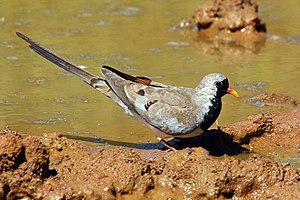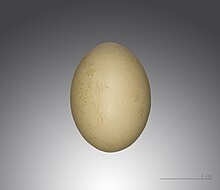Cap dove
| Cap dove | ||||||||||
|---|---|---|---|---|---|---|---|---|---|---|

Cape pigeon ( Oena capensis ), male |
||||||||||
| Systematics | ||||||||||
|
||||||||||
| Scientific name of the genus | ||||||||||
| Oena | ||||||||||
| Swainson , 1837 | ||||||||||
| Scientific name of the species | ||||||||||
| Oena capensis | ||||||||||
| ( Linnaeus , 1766) |
The Namaqua Dove ( Oena capensis ), also Maskentäubchen called, is an African pigeon bird . The species is the only representative of the Cape pigeon genus. The very long and pointed tail is characteristic of the species.
Appearance
The little pigeon is one of the smallest species of pigeon and, with a size of 24.5 to 25.5 centimeters and a weight of 40 grams, is not much larger or heavier than a diamond pigeon . The species shows a very conspicuous sexual dimorphism .
The male has a conspicuous face mask: the forehead, face, throat and chest are black. The rest of the head and the sides of the neck are sharply contrasted from this and are light blue-gray. The neck, the posterior neck, the back and the inner wing covers are of a very light brown. The underside of the body is white. The middle under tail cover is black. The rump is light gray-brown and has a black-lined white cross-band. The upper tail cover is gray-brown. The elytra are light gray and each have a spot that shimmers black to reddish. The outer tail feathers are blue-gray and have a black band at one end. The middle tail feathers are brownish gray. The beak is long and orange-red in relation to the head. It brightens to a yellow tone towards the tip. The iris is dark brown. The dark circles are gray.
The female lacks the black head mask. Her front head, front neck and chest are dull gray-brown. The forehead and throat are lightened. The elytra are brownish. The beak is dark brown.
distribution and habitat
Cape pigeons are found throughout tropical Africa. Their distribution area extends from Senegal via Sudan to the Red Sea and the southern parts of the Arabian Peninsula and south to South Africa. The subspecies Oena capensis aliena is native to Madagascar .
The habitat of the little cape is arid steppes, loosely forested regions and cultivated land. Cape pigeons are also found near human settlements and can be seen in gardens and parks.
behavior
Cape pigeons find their food mainly on the ground. The most important food component is small seeds. The breeding period of the pigeons is not tied to any season. A rich supply of ripening seeds triggers the brood. The nest is at a low altitude in the bushes. It is a loosely assembled structure with a shallow hollow. The clutch consists of two eggs with a cream-colored shell. Both parent birds breed. The incubation period is 14 days. The young leave the nest after 12 to 13 days and can fly at 16 days.
Keeping in human care
The small and interestingly colored cape pigeons are among the most frequently imported African pigeons. They were shown at the Amsterdam Zoo back in 1854. They were first bred in Germany in 1875. Cape pigeons are considered to be very peaceful aviary birds that cannot be kept with other small pigeon species, but with small birds such as finches . However, they are warmth-loving, sensitive to wet and cold weather and must be overwintered in a heated shelter.
The abundant food supply in captivity triggers a very strong brood instinct in Cape pigeons, as in many other desert species. It comes to box broods where the nestlings are abandoned by their parents birds, although they are not independent and not because of their sensitivity to cold brooded must be. Diamond pigeons are therefore often used as nurse birds for breeding Cape pigeons.
supporting documents
Individual evidence
literature
- David Gibbs, Eustace Barnes and John Cox: Pigeons and Doves - A Guide to the Pigeons and Doves of the World . Pica Press, Sussex 2001, ISBN 90-74345-26-3 .
- Alois Münst and Josef Wolters: Tauben - The species of wild pigeons , 2nd expanded and revised edition, Verlag Karin Wolters, Bottrop 1999, ISBN 3-9801504-9-6 .
- Gerhard Rösler: The wild pigeons of the earth - free living, keeping and breeding . M. & H. Schaper Verlag, Alfeld-Hannover 1996, ISBN 3-7944-0184-0 .


